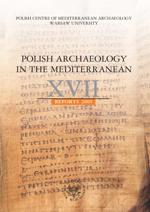LATE ROMAN/ EARLY BYZANTINE GLASS FROM THE BASILICA IN MAREA
LATE ROMAN/ EARLY BYZANTINE GLASS FROM THE BASILICA IN MAREA
Author(s): Renata KucharczykSubject(s): Archaeology
Published by: Wydawnictwa Uniwersytetu Warszawskiego
Keywords: Egypt; Marea; basilica; Late Roman period; Byzantine period; glass vessels; glass production
Summary/Abstract: Another season of excavations at the basilica yielded glass fragments in large quantities but of limited variety. They are characteristic of the glassware of the Late Roman/Early Byzantine period, that is, from the 4th to the 7th century, with a concentration coming in the 5th and 6th centuries AD. The record is dominated by closed vessels in the shape of bottles of various types, sizes and volumes. Next in quantity are lamps. Other standard forms of that period, including open forms, like wineglasses and everyday tablewares, are also represented. They are, however, definitely less numerous. The vast majority of fragments represent free-blown vessels finished with the use of a pontil. Most of them are plain. The ornamentation, if any, is simple and restricted to applied thread, painted elements or pinched decoration. A few shards bear a pattern executed in a ribbed mould. The recorded fragments were made of either greenish or greenish-blue glass. Uniform glass quality, vessel shapes and finishing indicate that the vessels were all manufactured in one region; most probably, they represent local production. The exceptional appearance of fragments of a bottle with elaborate trailed-on ornamentation suggests an import. Surprisingly enough, there is still no evidence for the use of windowpanes of any kind.
Journal: Polish Archaeology in the Mediterranean
- Issue Year: 2007
- Issue No: XVII
- Page Range: 70-74
- Page Count: 5
- Language: English

